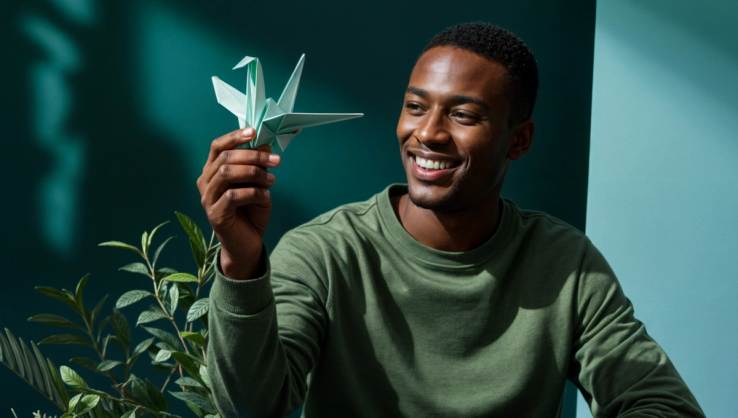
AI in Marketing: 10+ Tools for Your Next Campaign
Published 8 Feb, 2024
The AI marketing universe is bigger than you may think. B2B Product Strategist and Growth Advisor at Picsart, Tatevik Maytesyan explains why marketers need to pick up AI tools ASAP, and shares the AI tools she finds most valuable for her workflows and targets.
If you’re over a certain age, you likely remember a time when the computer was something that’d “blow over.” Evangelists evangelized, detractors detracted, but eventually the writing was on the wall/spreadsheet/your cousin’s blog: The people who learned to use this new tool early were far better off than those who waited for it to become mainstream.
If you’re a marketer, you’re living in the same kind of moment right now. According to Tatevik Maytesyan, B2B Product Strategist and Growth Advisor at Picsart, there are AI tools that can make your marketing workflows faster and more effective, with greater opportunities for needle-moving, boss-impressing results than ever.
At Unleash AI’s Power in Marketing Campaigns & Advertising, our virtual Gather & Grow webinar, Maytesyan showed us how marketers can use these tools to drive results that improve your campaigns, your strategy, your daily operations and your career as a whole.
With AI in marketing fast becoming a norm, those who master it will be invaluable assets on their team—so keep reading to learn about the AI landscape, including the tools Maytesyan recommends across marketing applications.
The AI Marketing Landscape
Tools like ChatGPT and Midjourney get a lot of airtime in the conversations surrounding AI in marketing. Though these tools are monumentally helpful, the AI marketing landscape goes well beyond text and image generators.
AI in marketing includes the generative AI domain we all know and love, but is also home to AI-driven data science, machine learning and general AI capabilities. According to Maytesyan, the marketer of the future is lightning-fast.
The future of AI in marketing is that we’re all going to get faster.

Considerations & Limitations of AI in Marketing
However you as a marketer choose to use these tools, Maytesyan says there are limitations and ethical considerations for what can be achieved. She suggests anyone putting together an AI marketing strategy considers the following benefits and drawbacks.
Benefits of AI in marketing
- Automation & efficiency: AI tools can make marketing tasks faster and easier, buying back time to be spent on other value-adding aspects of the role. More time can be spent on strategic tasks, or on experimentation; things for which time may have been in short supply.
- Decision-making: Certain AI tools, such as Plat.AI, can be used in ways that make the best decision for a campaign, strategy or asset clearer. By collating and presenting large data sets without the threat of human error, a marketer’s effort can be put towards interpretation rather than administration.
- Personalization: Some AI tools allow for or encourage personalization in their output, leading to more personalized communications, assets and marketing materials on the consumer end. More personalization often translates to deeper engagement, without the high cost of time and labor required to personalize assets by hand.
Drawbacks of AI in marketing
- Security: The data sets AI tools pull from may sometimes violate privacy laws in how they collect, use and share personal information. Depending on the tool, most of what’s been collected by an AI tool isn't done with the explicit permission—rather, an “implied” permission—by the person whose data has been taken.
- Ethics: AI output can sometimes closely mirror or (arguably) replicate existing works, leading to claims of copyright infringement. Works generated by AI alone aren't entitled to protection under the U.S. Copyright Act, which could open up brands using these tools to legal ramifications. AI tools also don't typically offer credit to those whose work has influenced its output; notable when output resembles other work.
- Bias: Any time you’re pulling from a large data set, stereotypes abound. Though the most obvious example is a “default” to white, young, conventionally attractive representations of humans in image generators, algorithms can show the same lack of awareness: An AI recruitment system can discriminate against women and a predictive AI model can downgrade healthcare for black Americans. A recent study suggests AI bias may be even stronger than human bias.
It’s critical to keep these last considerations in mind, especially as a marketer. Ethical and legal qualifications aside, know that your first look at some predictive pre-campaign data may leave blind spots that need to be accounted for.
AI Applications in Marketing
At our Gather & Grow session, Maytesyan identified four categories of AI marketing tools: Planning, analysis, creative and service. Let’s look at each category, and learn how marketers can use the tools that fall under each one.
1. Planning (“the Assistant”)
Maytesyan describes AI planning tools as most useful for helping marketers brainstorm new tactics and strategies, conduct market research and interpret customer development interviews.
AI tools can do all the routine tasks for you.

GPT tools (ChatGPT, Jasper, etc.)
ChatGPT is one of many tools using the GPT (“generative pre-trained transformer,” AKA predictive text model) brain. But there are numerous custom GPTs and other GPT-based tools that may serve your customer research efforts just as well, if not better. You can use tools like Jasper, Writesonic and Bing’s AI-powered search features to help build a more comprehensive, less time-consuming understanding of your audience makeup.
Maytesyan uses GPT models to identify customer segments for specific products and services, and to find, summarize and compare reviews on competing products and services. These same tools can be used for market research, once competing brands and services have been identified (more on that below).
Gemini (formerly “Bard”)
Google’s Gemini, renamed from Bard, is known to be of more use to marketers for its currency. While a tool like ChatGPT may only pull from information up to 2021, Google’s GPT’s infinite digital dataset makes it more useful for up-to-date information gathering.
Maytesyan uses tools like Gemini to find companies competing for the same audience as her own. She offers a formula that works for her: “Find companies of this segment + estimate value/size of these segments.”
It’s not the best writer, though, so use it more for research than prose.
Supernormal
While many tools can recognize and transcribe human speech, the best ones for marketers are the ones that pick up on context, and format the resulting documents accordingly using speech analytics software. Proponents of tools like Supernormal say it’s able to recognize things like decisions and action items.
Maytesyan points to Supernormal AI as her personal assistant for note-taking during meetings. She uses Supernormal for the call recording and summary, and cleans it up for stakeholders with a GPT tool. From there, all internal parties can glean insights and plan accordingly.
Text-to-image generators (Midjourney, Dall-E 3, Picsart, etc.)
For communicating these insights visually to stakeholders, AI text-to-image models can be fed snippets of the most important points. Dall-E 3, Picsart and Midjourney are some such AI design tools, capable of turning snippets of text into presentation-ready images.
Maytesyan uses text-to-image tools to quickly communicate key customer/market learnings across teams. She puts the insights in one document, and generates Google Slides and visuals to accompany presentations.
2. Analysis (“the Data Partner”)
Maytesyan says one of AI’s greatest values to marketers is as a data partner. AI marketing tools are currently capable of data set analysis, large text processing and performance optimization.
These tools let you focus on strategy and insights instead of drowning in spreadsheets.

Google Sheets add-ons (PromptLoop, Coefficient, etc.)
Google Sheets may not be the first tool that comes to mind when you think of AI, but its many available add-ons can make quick sense of the walls of data marketers normally scale solo.
Tools like PromptLoop, Coefficient and other AI data add-ons can reduce the amount of time a marketer spends in spreadsheets. Maytesyan uses tools like these to transform, extract and summarize large data sets based on simple commands.
Reporting & analytics tools (Braze AI, Nanos AI, etc.)
Marketers can use AI reporting and marketing data analysis tools to speed up data collection. Tools like Braze AI and Nanos AI predictive suite are particularly helpful to marketers looking to get some quick dirt on their data.
Maytesyan uses AI reporting and analytics tools to get quick answers to layered questions. For instance, asking such tools for “CTR and CPC by account names for the last 10 days” yields immediate results without the need to learn complex formulas. Or any formulas, really.
Campaign optimization tools (Nanos AI)
A growing niche in the AI marketing world is in campaign performance optimization. Maytesyan says tools like Nanos AI are convenient background workers, continuously experimenting with your existing ad campaigns to find the best audiences to show your ads to.
Tools like this can also make recommendations for budgeting based on real-time performance, taking another item off the marketer’s plate.
Maytesyan uses AI campaign optimization tools to run continuous experimentation on paid ads, and to make suggestions for budget optimization.
3. Creative (“the Creative Wizard”)
It's no secret many marketers are stumped trying to produce strong creative at scale, and find themselves burning through time, money and people trying to do so.
Given the high demand for constant creative, AI tools can be instrumental in the hands of creative branding professionals. These tools are particularly useful for scaling ad creative, creating variations, generating copy, easing localization and saving money on things like photoshoots.
Marketers can now nail efficient production of advertising content at scale.

Text-to-image generators (Midjourney, Dall-E , Picsart, etc.)
AI’s household names aren’t just for designers. They’re most useful in the hands of designers, to be sure—but marketers know they can’t be knocking on design’s door with every new idea. Marketers can use AI tools like Midjourney, Dall-E 3 or Picsart’s text-to-image generator for concepting and ideation, and mock up what they need quickly before tagging design.
Maytesyan uses AI text-to-image generators to enhance, extend or adjust existing ad creative when she needs it done quickly. I.e. if an existing ad suddenly needs to suit a different platform’s visual constraints, AI image tools can “extend” the ad image to fit the platform.
GPT tools (ChatGPT, Jasper, etc.)
You’ve probably tried your hand at writing emails with ChatGPT and Jasper, and maybe even found success doing so. But GPT-based tools are also of service in how they can help time-strapped marketers craft copy for public-facing assets when necessary.
Maytesyan uses GPT tools for a first draft of quick, brand-aligned copy for socials, emails and other less intensive marketing assets.
4. Service (“the Optimizer”)
Maytesyan says we’re all most familiar with service-oriented AI marketing tools from a consumer standpoint. We’ve all encountered chatbots and automated customer support models that not only attempt to resolve user issues, but are often set up to subtly move prospects into or further down the marketing funnel.
AI tools are also gaining popularity in marketing for their product and service customization, making brands better able to tailor offerings to specific groups. Think of Spotify’s “wrapped.”
You can streamline processes, and make it easy for your customer to engage with your brand.

Trained AI Chatbots
While not an obvious marketing function, the AI chatbots we’re familiar with can be trained to serve marketing purposes. Maytesyan points to Sephora’s chatbot as a perfect example of how a chatbot specifically trained on a brand’s offerings can customize conversations and personalize product suggestions, acting as a 24/7, onsite marketer for prospects.
Maytesyan says chatbots trained on a brand’s services and products can be an extension of a company’s marketing.
Use AI to Expedite and Enhance Marketing Outcomes
AI’s acceleration in recent years is building a new breed of marketer: Those who wield these tools to take their mind off rote administrative tasks, sharpening their focus on the bigger picture.
With this refined focus comes more effective campaigns, efficient workflows and stronger business outcomes across the board.
All this to say, marketers can reap untold rewards from AI, especially if they master the tools before they become commonplace. Consider this your PSA. 😉
David is a Senior Content Marketer at Superside. A former journalist with bylines too numerous to enumerate, he brings his love of storytelling and semantics to the marketing world. Recognizing the sizable gaps in the creative-as-a-service (CaaS) sector, he jumped at the chance to fill the creative void for ambitious brands. In his off hours, he enjoys loud music, making vegan meals and being made fun of for making vegan meals. He’ll gladly talk to you about any of the above on LinkedIn.














